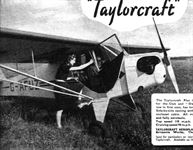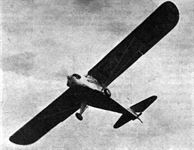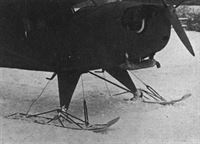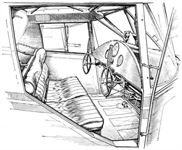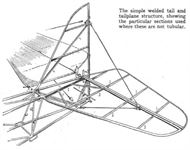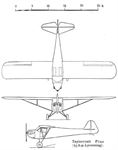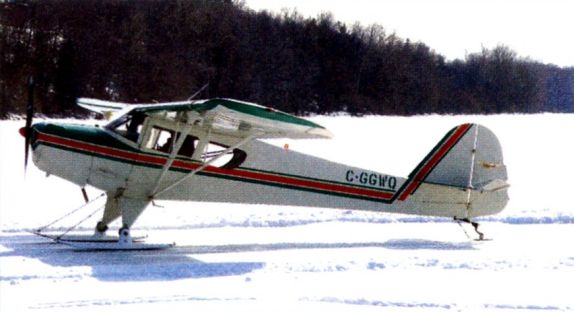
A / B / F-19 / F-21 / F-22
Taylorcraft (США). Самолеты
С. Гилберт Тейлор после того, как оставил "Taylor Aircraft Company", основал в 1936 году в Элаенс, штат Огайо, фирму "Taylorcraft Aviation Company"; в конце года наименование изменилось на "Taylor-Young Airplane Company", а в 1940 году - на "Taylorcraft Aviation Corporation".
Тейлор спроектировал Cub, ставший бестселлером, и в своей новой фирме решил продолжить развивать компоновку Cub, но увеличить ширину фюзеляжа для размещения пассажиров бок о бок.
В 1937 году был представлен подкосный высокоплан с закрытой кабиной для двух человек - Taylor-Young Model A с мотором Continental A40-4 мощностью 40 л. с. Самолет очень быстро нашел спрос. Построили более 600 Model A, прежде чем начался выпуск Model BC и Model BC-50 с мотором Continental A50 мощностью 50 л. с.
Подварианты "BC" включают Model BC-65, BC-12-65 (двигатель Continental A65 мощностью 65 л. с.), Model BF-50, BF-60, BF-65 и BF-12-65 с моторами Franklin и Model BL-50, BL-55, BL-65 и BL-12-65 с моторами Lycoming.
Такие самолеты выпускали тысячами, а главной проблемой фирмы стало удовлетворение спроса на них. Тем не менее фирма нашла время для разработки модификации с размещением летчика и пассажира тандемом: в конце 1941 года появился Tandem DC-65.
<...>
В 1968 году для обеспечения эксплуатации огромного количества самолетов марки Taylorcraft была образована компания "Taylorcraft Aviation Corporation". В 1973 году она приступила к выпуску двухместного, с расположением членов экипажа бок о бок, самолета Model F-19 Sportsman 100, спроектированного на основе довоенного Model B. За ним в 1980 году последовал самолет Model F-21, а в 1983 году - Model F-21A с баками увеличенной емкости. В 1990 году выполнил первый полет самолет F-22 с мотором Textron Lycoming O-235-L2C. Вариант F-22A отличался шасси с носовой опорой, а запаса топлива хватало почти на шесть часов полета. На варианте F-22C стоял более мощный мотор O-360. До прекращения производства в октябре 1992 года построили относительно немного самолетов F-22 всех вариантов.
Описание:
- A / B / F-19 / F-21 / F-22
- Flight, August 1939
MUCH IN MINIATURE - Flight, September 1939
To-day's Light Aeroplanes - Flight, November 1939
Britain's Civil Aircraft
Фотографии
-
Мировая Авиация 245
Регистрационный номер: C-GGWQ [2] Model 19 Sportsman с мотором Continental O-200 мощностью 100 л. с. представлял собой улучшенный вариант самолета Model B. На фотографии - канадский самолет с лыжным шасси.
-
Мировая Авиация 246
Регистрационный номер: N4418F Самолет Model F-21 оснащен 4-цилиндровым мотором Lycoming O-235-L26 мощностью 118 л. с. (88 кВт), максимальная скорость на уровне моря - 201 км/ч, дальность полета - 644 км. Аналогичными характеристиками обладает и вариант F-21B.
-
Aeroplane Monthly 1991-07 / M.Vines - Sun'n'Fun'n'Floats
A line-up of floatplanes with a Taylorcraft in the foreground and a Maule immediately behind.
Другие самолёты на фотографии: Maule M-4 - США - 1957
-
Aeroplane Monthly 1987-04 / M.Jerram - For Business and Pleasure
Регистрационный номер: G-AFDN [5] The first imported Taylorcraft Model A was G-AFDN. In July 1941 it was impressed but was declared unsuitable for Service use and was never given an RAF serial number.
-
Air-Britain Archive 1984-03
Регистрационный номер: G-AFDN [5] The Taylor Young Model A G-AFDN at a pre-war gathering, possibly the RAeS Garden Party at Heathrow on May 8th 1938 (?) Though impressed on 31.7.41 it was soc 1.12.41 as unsuitable, being used as an instructional airframe at Bury St.Edmonds. It did not survive to be restored after the war.
-
Aeroplane Monthly 1990-06 / J.Meadows - Flying for fun (1)
Регистрационный номер: G-AFDN [5] Taylorcraft Model A G-AFDN owned by a Mr Prentice and almost certainly the same aircraft referred to by the author.
-
Air-Britain Archive 1987-02
Регистрационный номер: G-AFDN [5] G-AFDN, the first British-registered Taylorcraft A (40 hp Continental A-40) seen early in 1938 after being imported from America, with its new owner Mr Courtney N. Prentice.
-
Aeroplane Monthly 1987-04 / M.Jerram - For Business and Pleasure
Регистрационный номер: G-AFJP Taylorcraft Model A G-AFJP, imported from America in 1938, flew initially with the South Staffs Aero Club at Meir. In October 1953 'JP crashed at Woodbridge.
-
Flight 1939-07 / Flight Advertisements
Регистрационный номер: G-AFNW The Taylorcraft Plus has the tremendous advantages of side-by-side seating and dual control in a totally enclosed cabin. Could anything be better for the pupil (or the instructor for that matter) than this new British trainer craft with its steel construction and almost foolproof flying stability?
-
Aeroplane Monthly 1987-04 / M.Jerram - For Business and Pleasure
Регистрационный номер: G-AFUA [2] Taylorcraft Plus C G-AFUA, built in 1939, was initially owned by Mailing Aviation Ltd and based at West Mailing, Kent.
-
Air-Britain Archive 1985-04
Регистрационный номер: G-AFUA [2] From Bernard Martin's collection comes this early postwar view of Taylorcraft Plus C G-AFUA. The aircraft was stored during the war but had only a short subsequent career as it crashed on 18.10.48 at Northaw, Middlesex. Also present at the anonymous location is Moth Minor G-AFNG and a Messenger, so we can put the date between 11.46 and 10.48.
Другие самолёты на фотографии: De Havilland Moth Minor / D.H.94 - Великобритания - 1937
-
Flight 1939-09 / Flight Advertisements
Регистрационный номер: G-AFUZ The Taylorcraft Plus is an ideal plane for the Club and "Owner-Pilot." It is low in first cost, has low operating costs. Side-by-side seating with dual control in enclosed cabin. All metal construction and fully aerobatic. Top speed 110 m.p.h. Cruising speed 90 m.p.h. Price L500.
-
Aeroplane Monthly 1977-09 / A.Hitchman - Auster ancestry (1)
Регистрационный номер: G-AFVU [6] This Taylorcraft Plus C, owned by the Romford Flying Club, was burnt in a hangar fire at Maylands on February 6, 1940.
-
Flight 1939-09 / Flight
Регистрационный номер: G-AFVU [6] The simple and conventional lines of the Taylorcraft are obvious in this flying view. The separate trimming surface may just be seen below the elevators.
-
Aeroplane Monthly 1987-04 / M.Jerram - For Business and Pleasure
Регистрационный номер: G-AFVU [6] Taylorcraft director A. L. Wykes demonstrates the Plus C G-AFVU at Sir Lindsay Everard’s private aerodrome at Ratcliffe on July 28, 1939.
-
Aeroplane Monthly 1987-04 / M.Jerram - For Business and Pleasure
Регистрационный номер: G-AFVU [6] Robustly conventional best describes the general design of the Taylorcraft, flying view of which are shown here. The front screen, incidentally, is flat, so there is little or no distortion of view. When the photographs were taken the machine was being flown by Mr. A. L. Wykes, one of the directors of the company concerned with its manufacture. Twenty-five examples have already been sold to various clubs.
-
Aeroplane Monthly 1983-02 / L.Curtis - Flying for all
Регистрационный номер: G-AFVU [6] This Taylorcraft Plus C was operated by the Romford Flying Club at May lands in 1939.
-
Flight 1939-08 / Flight
Регистрационный номер: G-AFVU [6] The Taylorcraft at its test and demonstration base - Ratcliffe, Sir Lindsay Everard’s private aerodrome - with the control tower in the background.
-
Flight 1939-07 / Flight Advertisements
The 55 h.p. engine provides a cruising speed of 100 m.p.h. and the machine is fully aerobatic with a very low landing speed. The price is £479. Technical information with pleasure on request
-
Aeroplane Monthly 1979-04 / Personal album
This Taylorcraft, 2002 of the South African Air Force, visited Watercloof in February 1942. It was one of 38 impressed South African civil aircraft allocated serials in the sequence 2001 to 2038.
-
Jane's All the World Aircraft 1980 / Encyclopedia of Aviation - Aircraft A-Z - v5
Регистрационный номер: C-GGWQ [2] Taylorcraft Model F-19 Sportsman 100.
-
Aviation Historian 8 / R.Mulder - Capital Gains: Oslo-Fornebu airport 1934-40
Регистрационный номер: LN-FAG Opening day, June 1, 1939; as well as the various airliners on show, three privately-owned aircraft were on hand to celebrate the airport’s inauguration. They were Taylor J-2 Cub LN-EAN (the tail of which is visible here), Taylorcraft A LN-FAG and Fairchild 24 LN-EAF. In the background is DNL’s Caproni Ca 310 LN-DAK Brevduen.
Другие самолёты на фотографии: Caproni Ca.310 Libeccio - Италия - 1937Fairchild C-61 Forwarder / Model 24 / Argus - США - 1932Taylor Cub - США - 1931
-
Flight 1940-03 / Flight
FIRST SKIS IN ENGLAND? During the recent wintry weather one of the new Taylorcrafts with the latest 75 h.p. Lycoming engine was fitted with light skis. They were built in twelve hours and proved highly successful.
-
Мировая Авиация 245
Редкий Model BL-50 с поплавковым шасси построили в 1938 году с целью установления рекорда беспосадочного перелета поплавкового гидроплана из Лонг-Айленда, Нью-Йорк, в Дайтона-Бич, Флорида.
-
Flight 1939-08 / Flight
A good idea of the layout and comparative spaciousness of the two-seater cabin is obtainable from this drawing. Luggage is carried behind the squab. The neatness of the control and instrument layout is particularly noteworthy.
-
Flight 1939-08 / Flight
The simple welded tail and tailplane structure, showing the particular sections used where these are not tubular.
-
Flight 1939-08 / Flight
A separate trimmong surface is used in the Taylorcraft; this can be seen, in "gliding" position, below the tailplane. Notice the inspection zips and the lifting handle on the right.
-
Flight 1939-09 / Flight
Taylorcraft Plus (55 h.p. Lycoming).
- Фотографии












